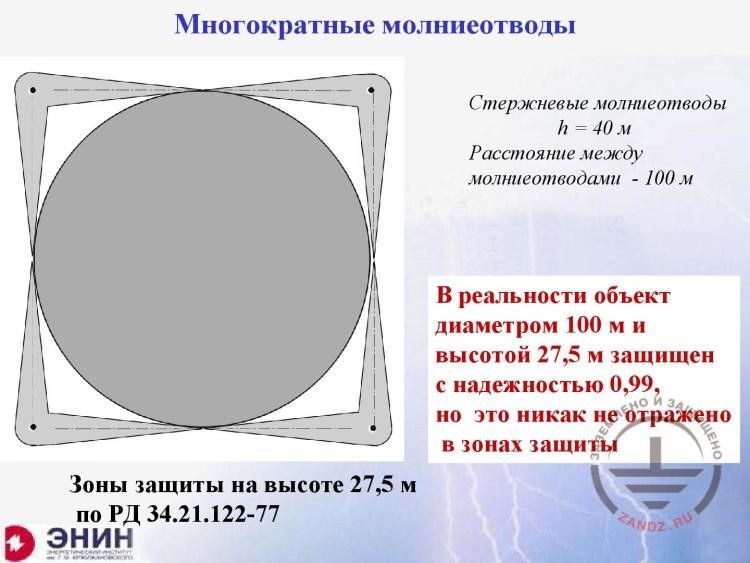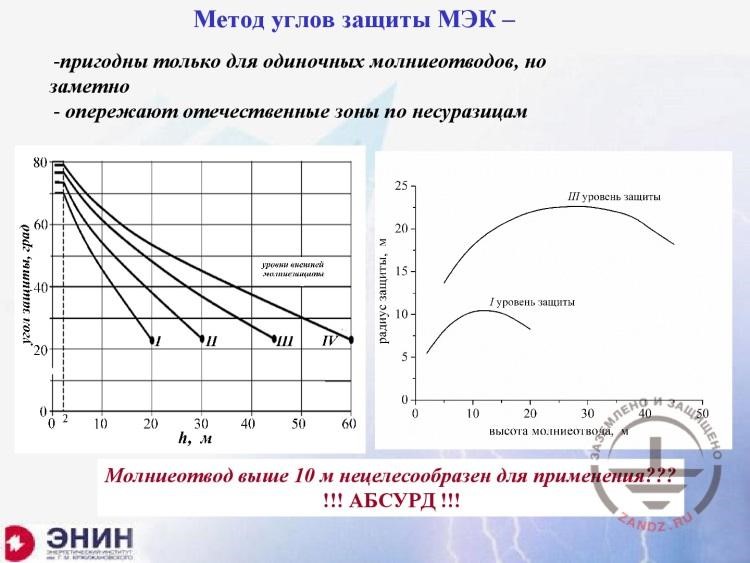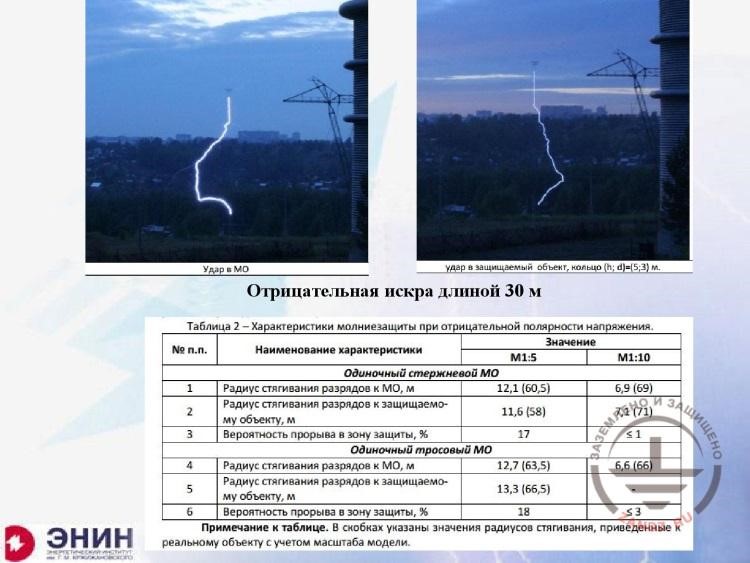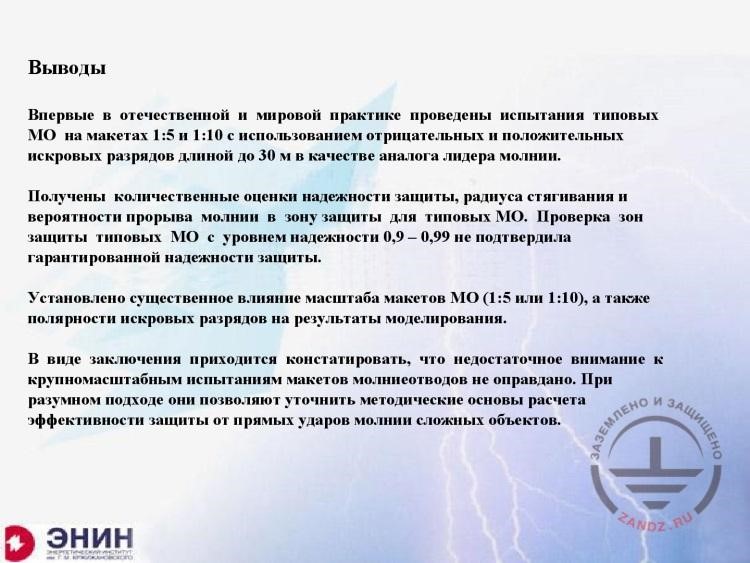The nineteenth webinar of "Earthing and Lightning Protection: Design Issues and Problems" series.
Webinar text. Page 3
Fast navigation by slides:
<< Page 1:
1. Origin of lightning protection zones
2. Protection against the lightning current interference
3. Methods for recording the lightning strike point
4. What was the originators' way of thinking?
5. Protection radius of lightning arresters
6. Research of I.S. Stekolnikov
7. Preceding lightning arresters
8. First protection zones
<< Page 2:
9. Laboratory research in Russia
10. Protection zone according to Akopyan
11. Particular configuration of the protection zone
12. How to determine the protection zone dimensions?
13. Searching for the orientation mechanism
14. Determining protection zones in the laboratory
15. Probabilistic method, ENIN modification
16. Method assumptions
Page 3:
17. CIGRE data for high-voltage power lines
18. What problems do protection zones for lightning arresters entail?
19. Multiple lightning arresters
20. IEC shielding angle method
21. What tasks are solved in the laboratory today?
22. Negative spark of 30 m long
23. Report conclusions
24. Questions and answers
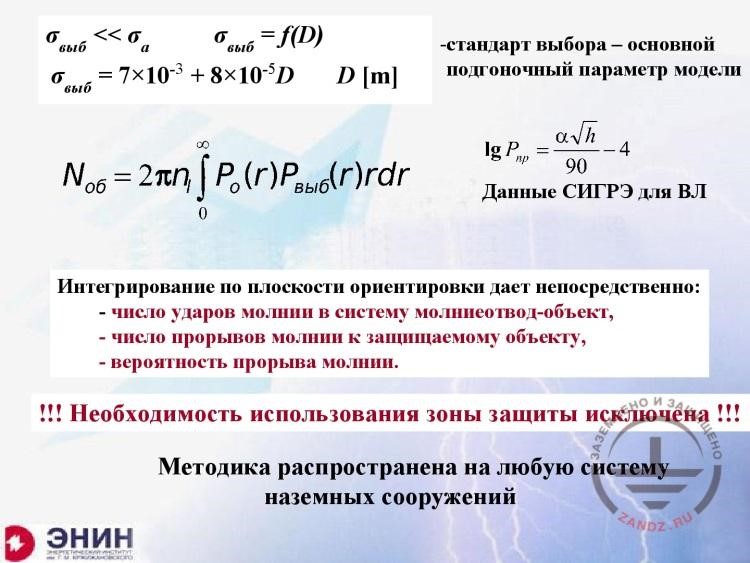
CIGRE data for high-voltage power lines
| - стандарт выбора – основной подгоночный параметр модели | – choosing standard is the main adjustment parameter of the model |
| Данные СИГРЭ для ВЛ | CIGRE data for high-voltage power lines |
| Интегрирование по плоскости ориентировки дает непосредственно: - число ударов молнии в систему молниеотвод-объект, - число прорывов молнии к защищаемому объекту, - вероятность прорыва молнии. |
Integration by the orientation surface provides directly: – the number of lightning strikes into the “lightning arrester – facility” system, – the number of the lightning breakthroughs to the facility to be protected, – the probability of the lightning breakthrough. |
| !!! Необходимость использования зоны защиты исключена !!! | !!! The need to use the protection zone is eliminated !!! |
| Методика распространена на любую систему наземных сооружений | The method is applied to any system of on ground structures |
– Using these three adjustment parameters, this reliable statistics was processed. The statistics was collected by CIGRE. It relates to power lines. Two specialists, Vladimir Burgsdorf and Mikhail Kostenko, processed the statistics in Russia in the 1950s. Based on this statistics, the design model parameters were determined, and the protection zones were generated on the basis of these design parameters. The protection zones provided in regulatory documents RD 34 and SO-153 and so on. This is where the protection zones came from.
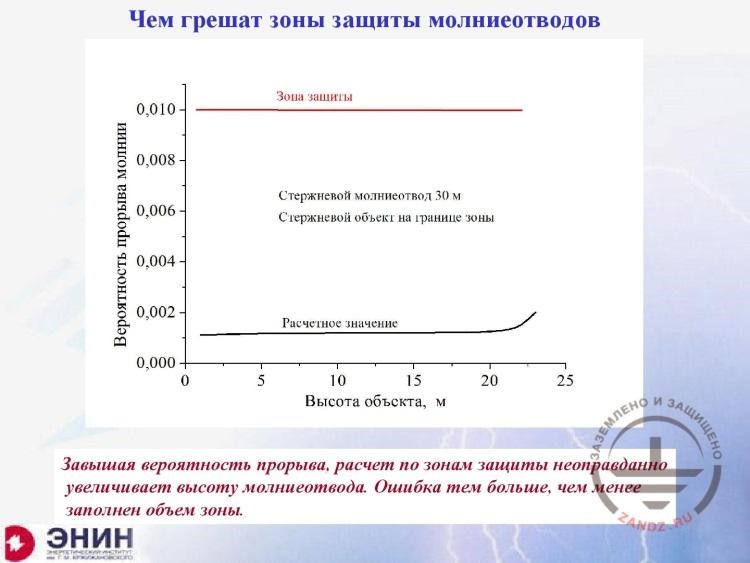
What problems do protection zones for lightning arresters entail?
| Чем грешат зоны защиты молниеотводов | What problems do protection zones for lightning arresters entail? |
| Зона защиты | Protection zone |
| Вероятность прорыва молнии | Probability of the lightning breakthrough |
| Стержневой молниеотвод 30 м | Lightning rod, 30 m |
| Стержневой объект на границе зоны | Rod-type facility in the zone boundary |
| Расчетное значение | Calculated value |
| Высота объекта, м | Facility height, m |
– The protection zones in document RD 34 have no reliability. In SO-153, particular values for the protection reliability are specified because there is a protection zone having a reliability of 0.9, 0.99, and 0.999. What kind of reliability is it? It means the following: if you fill the protection zone with facilities, i.e. the entire zone will be filled with the facilities, you will obtain the protection reliability that is specified for the zones. But in the vast majority of cases, the protection zone is almost empty. The facility occupies very little space within the zone. But look at what happens if I do the following: I have got a protection zone with a reliability of 0.99...here it is... and now I place a facility as a single rod. This facility occupies a very small part of the protection zone. And the reliability of this protection zone has become closer to 0.999 instead of 0.99. It means that the breakthrough probability is actually close to 0.001 instead of 0.01, which is specified for the zone. It means that the lightning arrester I have chosen has an unreasonable excess in terms of its height.
| Многократные молниеотводы | Multiple lightning arresters |
| Стержневые молниеотводы | Lightning rods |
| h = 40 м | h = 40 m |
| Расстояние между молниеотводами - 100 м | Distance between the lightning arresters — 100 m |
| В реальности объект диаметром 100 м и высотой 27,5 м защищен с надежностью 0,99, но это никак не отражено в зонах защиты | In real life, the facility having a diameter of 100 m and a height of 27.5 m, is protected with the reliability of 0.99, but it is not reflected in the protection zones |
| Зоны защиты на высоте 27,5 м по РД 34.21.122-77 | Protection zones at the height of 27.5 m according to RD 34.21.122-77 |
– Here is the second point associated with the protection zones. The protection zones could be described mathematically and generated for only two variants: single lightning arrester and double lightning arrester. And the double arrester should be made of components of equal type: either a double rod, or a double wire. Let's see what it results in. I have got a facility having a radius of 100 meters and a height of 27.5 meters. It is a huge reservoir protected with the lightning arresters. In the figure, the lightning arresters shown by the dots are placed in the corners of 40 meters. For them, at the height of 27.5 meters, a protection zone was generated, and these protection zones are extended in the form of bands. The facility itself appears to be unprotected in terms of protection zones. But if we make calculations using the calculating method, it turns out that it is protected by these lightning arresters very well. Its protection reliability is 0.99. And to achieve such reliability, we need the lightning arresters of 40 meters high instead of 85 meters which have been used in the design created according to the protection zones. I have cut down the lightning arrester height 2-fold, which means that I have provided 4-fold savings in terms of dangerous electromagnetic effects. This is achieved when we stop using the protection zones.
| Метод углов защиты МЭК - | Shielding angle method by IEC |
| - пригодны только для одиночных молниеотводов, но заметно | – suitable only for single lightning arresters but contain significantly |
| - опережают отечественные зоны по несуразицам | – more mistakes than the Russian zones |
| угол защиты, град | Shielding angle, degrees |
| Уровни внешней молниезащиты | External lightning protection angles |
| h, м | h, m |
| радиус защиты, м | protection radius, m |
| I уровень защиты | protection Level I |
| высота молниеотвода, м | lightning protection height, m |
| III уровень защиты | protection Level III |
| Молниеотвод выше 10 м нецелесообразен для применения??? | The use of the lightning protection higher than 10 m is not feasible??? |
| !!! АБСУРД !!! | !!! AN ABSURD !!! |
– What is the situation in the western countries? This question emerges all the time. Generation of the protection zone in the form I have mentioned, wherein they protrude from the lightning arrester's top, which is incorrect, and this is provided by the IEC standard. And in the IEC standard, depending on the lightning arrester height, an angle is created, according to which the protection zone is located, for the first level of lightning protection — with the reliability of 0.98, for the second level, it is 0.95, and for the third level, it is 0.9, and finally, for the fourth level, it is 0.8. If I build the protected space according to these calculation curves I have got, I will obtain the following result: the first protection level with the reliability of 0.98. First, the zone size increases from the lightning arrester height, and then it begins decreasing.
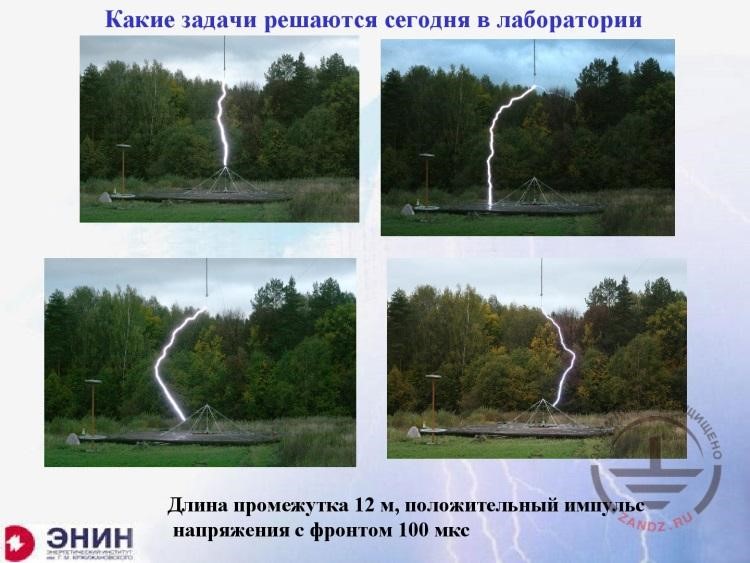
What tasks are solved in the laboratory today?
| Какие задачи решаются сегодня в лаборатории | What tasks are solved in the laboratory today |
| Длина промежутка 12 м, положительный импульс напряжения с фронтом 100 мкс | Gap length is 12 m, positive voltage pulse with the 100 mcs front |
– Have any attempts been recently taken to clarify the protection zones somehow? They have. Moreover, I have participated in this work directly. We have performed a huge work, for which significant amount of money were allocated. It was done for the Russian power industry, and, during this field work, by using the long spark of 12 to 30 meters, a protective action of the lightning arresters was studied in these models. The experiments shown in this slide were conducted near Moscow, in Istra.
| Удар в МО | Strike into the lightning arrester |
| Удар в защищаемый объект, кольцо (h; d)=(5;3) м | Strike into the protected facility, ring (h; d)=(5; 3) m |
| Отрицательная искра длиной 30 м | Negative spark of 30 m long |
| Таблица 2 – Характеристики молниезащиты при отрицательной полярности напряжения. | Table 2. Characteristics of lightning protection with the negative voltage polarity. |
| № п.п. | No. |
| Наименование характеристики | Characteristic |
| Значение | Value |
| М1:5 | Scale 1 : 5 |
| М1:10 | Scale 1 : 10 |
| Одиночный стержневой МО | Single lightning rod |
| Радиус стягивания разрядов к МО, м | Radius of discharge attraction to the lightning arrester, m |
| Радиус стягивания разрядов к защищаемому объекту, м | Radius of discharge attraction to the protected facility, m |
| Вероятность прорыва в зону защиты, % | Probability of breakthrough to the protection zone, % |
| Одиночный тросовый МО | Single wire lightning arrester |
| Радиус стягивания разрядов к МО, м | Radius of discharge attraction to the lightning arrester, m |
| Радиус стягивания разрядов к защищаемому объекту, м | Radius of discharge attraction to the protected facility, m |
| Вероятность прорыва в зону защиты, % | Probability of breakthrough to the protection zone, % |
| Примечание к таблице. В скобках указаны значения радиусов стягивания, приведенные к реальному объекту с учетом масштаба модели. | Comment for the table. The values of attraction radii are shown in brackets, which are normalized for the real facility taking into account the model scale. |
| Выводы | Conclusions |
| Впервые в отечественной и мировой практике проведены испытания типовых МО на макетах 1:5 и 1:10 с использованием отрицательных и положительных искровых разрядов длиной до 30 м в качества аналога лидера молнии. | For the first time in the Russian and world practice, typical lightning arrester tests were performed in 1 : 5 and 1 : 10 models using negative and positive spark discharges with the length of up to 30 m as an equivalent to the lightning leader. |
| Получены количественные оценки надежности защиты, радиуса стягивания и вероятности прорыва молнии в зону защиты для типовых МО. Проверка зон защиты типовых МО с уровнем надежности 0,9-0,99 не подтвердила гарантированной надежности защиты. | Quantitative estimates of the protection reliability, attraction radii and lightning breakthrough probabilities into the protection zone for the typical lightning arresters were obtained. Verification of the protection zones for the typical lightning arresters with the reliability level of 0.9–0.99 did not confirm the guaranteed protection reliability. |
| Установлено существенное влияние масштаба макетов МО (1:5 или 1:10), а также полярности искровых разрядов на результаты моделирования. | A significant impact of the lightning arrester models scales (1 : 5 or 1 : 10) as well as of the polarity of the spark discharges on modelling results were determined. |
| В виде заключения приходится констатировать, что недостаточное внимание к крупномасштабным испытаниям макетов молниеотводов не оправдано. При разумном подходе они позволяют уточнить методические основы расчета эффективности защиты от прямых ударов молнии сложных объектов. | Instead of conclusion we have to state that low attention to large-scale tests of the lightning arrester models is not justified. Using the reasonable approach, they allow refining the methodical base of the calculation of efficiency of protection against the direct lightning strikes into the complex facilities. |
– I have intentionally highlighted the conclusions obtained from the reports generated after these experiments. I will read those conclusions for you because they are very important. The first conclusion: for the first time in the Russian practice, the tests were conducted, the quantitative estimates for the protection zones reliability were obtained, and during the check of the protection zones with the reliability level of 0.9–0.99, no confirmation for the guaranteed protection reliability was achieved. A significant impact of the model scales as well as the of spark discharge polarity were determined. It is not new. Unfortunately, we can do nothing with the results of these experiments or refine the protection zones.
What is left? Certainly, you may design the lightning protection according to the protection zones. You may be sure that you can use higher lightning arresters in almost all cases. But you have got a software that does not use the protection zones but offers you the following: use this software to calculate the number of strikes into the lightning arresters you have installed. It will yield the number of breakthroughs into the protected facilities and, thus, the protection reliability, if you divide the former by the latter. And this software is available. It is officially approved for use in the Russian Federation. Technical Bulletin 29/2009 of the Roselectromontazh company stipulates the use of this software for design purposes. And such Technical Bulletin is issued by this association with the Gostekhnadzor's support. And this software is available within the "Earthing and Lightning Protection at ZANDZ.com" project and is distributed free of charge. The seminar dedicated to this software was held in the last month. And also in the last month, we discussed how to work with this software. I want to add the following point to this: the software can be used for the calculation of the facility of any configuration protected by any type of a lightning arrester. To simulate lightning arresters and facilities, the software uses the "Lego" principle. There is a set of typical elements: rods, wires, rectangles, cylinders, trapezoids, spheres, semi-spheres; you can use them to arrange a facility of any configuration by installing them on the earth side-by-side, as necessary. After you have set up such system, you may install any type of lightning arrester in it: rod-type, wire-type, whatever you want. Press the "Count" button, and in 10–15 seconds, you will see the number of strikes into the system, the number of the lightning breakthroughs into the protected facility, and the lightning breakthrough probability. If you know the probability, then by subtracting it from 1, you will obtain the protection reliability. You can do that as follows: you can take the entire building or, for example, choose the protection reliability of only one tower that is built on the Tsar Dadon’s palace where the Golden Cockerel lives. Mark this tower as a facility and all other items as lightning arresters, and you will obtain the number of strikes that affect the Golden Cockerel. It means that you can make any combinations using this software. Does it have to be improved? It does. And such improvements will be made sooner or later. They also relate to the increase in the protection reliability. The main point is that they relate to the following: the number of lightning strikes is non-important for me unlike the number of dangerous lightning strikes. I.e., lightnings with a certain current. Today, it calculates all the lightnings in total. In the future, the calculations will be performed for the lightning with the certain current level that presents danger for the facility. This is an issue of the future, but not very distant future. Therefore, as a conclusion, I can say that calculations according to the protection zones are the least reliable type of calculations. This is the first point. The second point is: calculations according to the protection zones in all cases mean that the height of the lightning arresters will be higher than you need.
Questions and answers
– Thank you, Eduard Meerovich! We have got questions. Let's start their discussion now. The first question is rather large. Victor asked: "Hello, Eduard Meerovich! I want to ask you about unreasonably excessive height. The expert board requires to install lightning arresters to protect the roofed boiler houses located on the high-rise apartment buildings. According to the calculation, the height of the lightning arrester installed on a residential building roof at the height of 50 meters is, based on my experience, more than 10 m (10 to 16 m). Can you write an article for Rostekhnadzor or GlavGosExpertiza on behalf of ENIN to clarify this issue or at least publish this article in the "Electrotechnical News" magazine to discuss it?"
– You know, we can. Moreover, I think that your issue is important because, according to the Russian standards, the lightning arrester’s height is calculated from the earth level, but due to this fact, single and double lightning arresters should have a significant elevation over the roof where the items are installed. We can get round this by using the closed wire lightning arresters that we recommended in the last webinar. You can also use their modification: install a system of lightning rods with low elevation instead of wire lightning arresters. If you need such article and if the administration of the "Earthing and Lightning Protection at ZANDZ.com" project supports this idea, I am ready to clarify this, and such article may be published over the Internet. I think it is a correct approach. Thank you very much.
– Thank you for your answer. One more question from Victor: "What do you think, can we somehow reduce number of strikes into the 500–1,100 kV high-voltage power line? Should we protect it or it is better to strengthen the insulation and reduce its breakthrough probability?"
– This question refers to another subject, but the point is that we have got no voltage of 1,000 kV. The limit value for the power lines in Russia is only 750 kV. It is because the 1,150 kV line is actually located in the territory of Kazakhstan and is not operated. But even for the 750 kV voltage class, there exists a danger that the operating voltage that has a polarity opposite to the thundercloud may attract the lightning discharges more efficiently. Such danger exists. These studies were conducted. They are used, and for the 750 kV power lines, the situation is not very dangerous; however, in case of higher voltages, for example, 1,150 kV, it is a real danger. You must use the protection for the following reason: because if you strengthen the insulation, then it is, first, very expensive due to the fact that the insulation strengthening always means addition of the amount of metal used for the support. The support becomes higher and wider, and it is also more expensive. The second point is: unfortunately, we could not achieve a significant effect by strengthening insulation and thereby reduce the number of strikes, leaving the line without lightning protection at all. And if you want to avoid using the wire lightning protection, you have got another way to follow today, the installation of surge protectors directly on power line supports. This is very expensive. But in the locations where the wire operation is difficult, e.g., upon high wind and ice loads, this can be done even today, and the voltage class of 330 kV and 220 kV can be used.
– Next question from Alexander: "Will the supervisory authorities accept the results of calculations of the lightning protection according to the probabilistic method or should we show the protection zones they got used to in the drawings?"
– You will not be able to show the protection zones they got used to. This software provides an official protocol. This protocol is a document that finalizes the calculation. But the right to use this software for calculation, I repeat, is confirmed by Technical Bulletin 25/2009 of "Roselectromontazh" with the support of Gostekhnadzor. I think it is sufficient for the technical inspection.
– Alexander, please tell us if you understand the answer. If you need details, please specify. Another question is also from Alexander: "The distance between the current collectors (10, 15, 20, 25 m) is taken at the earth level or at the roof level, e.g., for the facilities shaped as a beveled cone in their cross-sections?"
– You know, the current collectors are believed to be installed with the shortest distance. It means that they should be generally located vertically. But the point is: if you have any doubts about where to measure this distance, then you have to measure it in the point where such distance is larger, i.e. in case of a beveled cone, it is at the earth surface. Since the distance at the top is smaller, current collectors will operate more efficiently and reduce the electromagnetic interference level more significantly because the step for current collector is chosen so that to reduce the electromagnetic interference levels within the building interior. The smaller the distances between current collectors, the better the electromagnetic interference are reduced. Therefore, if you use smaller distances, it will not cause any problems.
– Thank you. Next question from Anton: "Do we need to protect the modular transformer substation if it is installed in the field and in 20 meters from the high-rise residential buildings having the height of 30 meters?"
– The point is that the designers of this modular substation decide on whether the substation can be protected. If they have installed the means of protection against the direct strike into the substation itself, it will not damage the substation. If they have installed the means of protection for its circuits inside the modular structure, then you do not need to protect it. If they are not provided, you have to contact the substation manufacturers and ask which protection requirements should be applied thereto. If the substation is installed in the urban area and has got a high-rise building nearby that serves as a natural lightning arrester, and the substation is within the protection zone of this lightning arrester, you certainly do not need to protect it against the direct strikes. With regards to protection against the electromagnetic interference, it is, again, a question for the substation designers.
– Thank you. Alexander who asked a question about the supervisory authorities has provided several comments on that we should use the bulletin. In his turn, another Alexander has commented that the bulletin is, unfortunately, not a regulatory document. Perhaps, on your side, Eduard Meerovich, you may provide a couple of words regarding this.
– You know, the point is that, unfortunately, I cannot say that a document is regulatory or not. We have got such bulletin. It was created and supported by Gostekhnadzor. In general, I have no objections for some other people's objections on the use of software, and the reason is that the protection zones described in RD 34 or SO-153 have been generated exactly according to this software. In this case, we have to cancel these zones as well, but they exist.
– Thank you. Let's proceed with the questions. One more question from Maria: "If we have an earthing band for the trade and entertainment center and a transformer substation nearby, should we integrate the circuits?"
– There is a clear rule defined in the 7th edition of the Electrical Installations Code. It states that all earthing circuits of the facilities should be integrated into a single circuit. This requirement has not been canceled. But the Electrical Installations Code also states that: "...except for the conditions when the customer needs an individual earthing". So, I do not understand it clearly whether the customer needs an individual earthing. We have had a special webinar dedicated to the individual earthing. And during that special webinar we showed that if you do not integrate them, your two circuits will be located close to one another, and they will be interconnected anyway due to the conductive soil between them. And such conductive soil leads to the fact that the significant portion of the lightning current will get from one circuit to another, and vice versa. Therefore, this question has no sense to some extent.
– Thank you for your answer. Let's continue. Question from Igor: "When we increase the number of current collectors, we obtain less interferences due to parallelizing the lightning current paths? It means that we reduce the current in each current collector and thus reduce the electromagnetic interference? Do I understand it correctly?"
– You understand it completely correct. There are two points: on the one side, in each current collector, the portion of the current passing through it is reduced, and it means that if some electrical circuit of the facility is close to this current collector, the interference will just reduce due to the fact that the current there is also low. But there is another point. Imagine the following picture: a cylindrical object having the current collectors installed along the cylinder and equally spaced. Now, if you calculate the field from these current collectors in the center of the cylinder, it will be equal to zero. It means that you will not have a magnetic field in the center due to mutual shielding. If you move further from the center, the field will appear but it will be much weaker. There are two aspects: the first aspect is the one you mentioned, that the current is reduced in the conductor. And the second aspect is: when the current collectors act collectively, they compensate (neutralize) partially the magnetic field of each other. Therefore, the effect becomes even stronger.
– Thank you. There was a question about the webinar video. I want to answer it right now. The webinar video will be provided within a week. Let me continue. I can see that you offer subjects for future webinars. We will discuss them, analyze them after the webinar, and add the most popular subjects into the schedule to cover them in future. The next question is: "Will the drawbacks of calculations according to the IEC protection zones be considered in the new regulatory documents? What do you think?"
– I have already mentioned this in the previous webinar. The situation is as follows: today, each agency is worried about its regulatory documents and develops standards for themselves. But now we are concerned about the all-Russian standards. And we would have to add these and other comments for amendment and elaboration in such all-Russian standard. Who can develop a Russian standard? Those who get the money. We thought that the Russian Academy of Sciences was the most suitable option. In the previous lightning protection conference held in 2016 (a year ago), we addressed the Academy of Sciences, and our request was generally supported by the President of the Academy of Sciences. We had a hope that the respective working group would be created in the Academy of Sciences. It would get some financing, and such standard would be created within a reasonable time. But you know that there were very serious changes in the Academy of Sciences. Can we rely on that, in the nearest future, the Academy of Sciences will get interested in this issue? But I cannot answer this question because I am not a member of the Academy of Sciences and I do not know what is going on there. But if this work will start, it will be certainly done. Referring to our Krzhizhanovsky Energy Institute (ENIN), we have planned the development of new regulatory document. And if the Ministry of Sciences or some other agency supports this plan, we are ready to develop this standard not on paper because it is useless, but as software modules, which may solve the problem of choosing lightning arresters, this is the first point; the earthing devices, which is the second point, and the electromagnetic compatibility, and this is the third point. We are ready for this and we have developed applications accordingly. What will we have as a result of this? Unfortunately, I cannot answer this question.
– Thank you. Next question from Vasily: "Substation of class 6/0.4 kV at the height of 1,150 meters. Is there any specifics for calculating the lightning protection ?"
– In our regulatory documents, I repeat, in the Russian documents, the facility height is never taken into account. In the regulatory documents of other type, e.g., in Kirghizia, with lots of gorges, wherein the power lines are often installed there along with the substations, there is a specifics related to the lightning protection simplifying. But all of these measures are taken for the voltage level of higher classes starting from 110 kV. We have got no special requirements for the height in Russia at all, not in a single regulatory document.
– Alexander clarified: "For what building height the probabilistic method is used? Are there any height limitations?"
– I think that there are no limitations for the following reason: the protection zone height that exists today in regulatory document SO-153, is limited by 150 meters. Why does this limitation exist? It is only related to one point: because at the heights of over 150 meters, e.g., 200 meters and more, usually, the number of strikes is increased due to the upward lightnings. The lightnings that start not from the cloud but from the facility itself and go up into the thundercloud. Such upward lightnings are characterized by that it is easy to protect from them. Almost in all cases, they start from the highest point of the structure with 100% probability and do not cause any problems. Therefore, I would not say that this software provides height limitations.
– Question from Alexander: "How is the calculation method accepted abroad? Do they take it into account or do they still prefer the shielding angle method or the rolling sphere method?"
– The rolling sphere method can be described only with regards to Europe. It is widely used there. What is it based on? We tried to find the reasons. You know, we had a series of webinars held by the representatives of the International Electrotechnical Commission. There were three webinars of this type. After that, we had an agreement that a professor from Poland (I will not tell his name) would answer the questions given to him in advance. The main question was: what is the rolling sphere method based upon? How can he explain the problems arising from this method? We had an agreement that it would be an integrated webinar during which he would answer these questions. That person held three webinars and refused to take part in the fourth webinar providing an explanation that other experts specializing in other areas had to be engaged. We could not wait for those experts, but I do not want to get back to the mistakes caused by the rolling sphere method because we had a special webinar dedicated to this. By the way, I had a meeting with a developer of the rolling sphere method abroad. I asked him about what was this method based on, and he said that there were not basis for it; it just looks good.
– Alexander commented: "Great, it just looks good!"
– Yeah, it looks good. But you know that you cannot use everything that looks good.
– We have got one more question: "The facility is underground, under the high-voltage transmission line. How can we protect the facility?"
– From what? If you mean the protection against the lightning, then you do not need to protect it because the high-voltage transmission line is itself a lightning arrester. But in order to protect it from the short circuit currents, I need to know what kind of facility it is.
– Alexander, please let us know if we have answered your question. If not, then clarify. We have no questions regarding the webinar yet. I will highlight that several people asked to hold a webinar for the foundation earthing. I repeat, we will collect all data for this webinar and probably schedule and hold the webinar dedicated to this subject.
– May I answer? The point is that the administrators of the "Earthing and Lightning Protection at ZANDZ.com" project, when they had questions related to the earthing, they asked me to write an article for this, which will be published on the website. I made a promise to write such article after the webinar. When I work on the article, I will try to answer the question related to foundations and their use as earthing devices. If this material will not be sufficient for those who ask these questions, then we will think about repeating the webinar. But the article will be written soon.
– Great, thank you. I think that we will partially meet these demands when we have the material. Victor commented: "Thank you, Eduard Meerovich! We do not have to copy all European standards at once, but use them wisely".
– You know, I would have put that differently: the Russian lightning protection practice is a very good practice. I think it is senseless to destroy it only because we have joined the global market. Moreover, joining the global market itself was a more or less strange thing. I think that Gosstandard when it adopts new IEC standards and earns money on them does more harm than good.
– We have got a clarification from Alexander who asked about the underground facility located under the high-voltage transmission line. He says that these are the instruments in a well in the water drain.
– Then specify the requirements for these instruments and we will be able to understand if you need to protect them or probably not. More likely, not. But just in case, we need to understand the requirements. Because today the situation is as follows: we are talking about the electromagnetic compatibility now but not about the lightning protection. This problem is related to the current flowing from the support's earthing devices. It means that in order to understand if we need any means of protection, we have to know how the equipment was tested for the immunity to the electromagnetic effects. For this, the Russian standards exist and, using these standards, we need to determine the requirements for the supports. And after we know the requirements, we will be able to talk about the means of protection. It is the only possible way.
– Thank you. Alexander, please write a more detailed request to our e-mail and we will answer you more specifically. Dear colleagues, if you have got any questions left or if new questions related to the subject of this webinar emerge, please to write to our e-mail: info@zandz.com. Each question will be studied and answered more specifically and in more details. We have got more questions: "The expert board requires the use of horizontal bands. The house is 30 meters high. Lightning grid with the current collectors; the natural earthing circuit is connected to the main earthing bus. Why do they ask bands?"
– According to our standards, the bands are required each 20 meters along the height to ensure the potentials equalizing. They function this way. If you have got any metal connections that may act as such bands, e.g., if you have got glass units, which form an administrative building walls. And they are interconnected by the embedded parts of the intermediate floors. Certainly, in such case, you do not need any bands because their functions are provided by the glass units having the embedded parts. If the situation is different, then you must use such equalizing bands in the high-rise structures, and this requirement is justified and must be met.
– Thank you. Maria clarifies: "How can we install a horizontal equalizing electrode if the building has already been erected?" Maria also clarifies that the building has already been built and the company decided to complete it.
– This question is not for me. Such aspect should be considered in the design. I am neither a designer nor a constructor. We cannot answer this question for the following reason: have the current collectors been lowered? There are current collectors. If they are spaced by 10 meters, then it is not a problem to interconnect them with a horizontal band. I think it is an artificial question.
– Good. Dear colleagues, thank you very much for your participation. Eduard Meerovich, thank you for your excellent report and answers. Dear colleagues, visit our website, read the news, follow the events. We will probably hold next webinars at the beginning of the next year. Read the news. Thank you for everyone, once again. See you soon.
– Dear colleagues. First, thank you for joining our seminar. I thought that not all of you might be interested in such a history-related webinar. But I understand that I was wrong. Second, I beg your pardon for my attitude to the protection zones. You know, the point is that I began to work in the lightning protection area when such protection zones protruded from the lightning arresters' tops. This was an absurd situation. I remember what complex and long discussions were induced by the leading experts of that time, the ones who developed these protection zones. We had much time spent on convincing them that the protection zone should be lowered and that they should be lower than the lightning arrester. And we have managed to do that. Now, I try to continue this function from the other side of the barricade. I want to assure you that the use of the protection zone is not incorrect, it is just an economically unjustified activity. The earlier you accept more perfect tool, the better your designs will be. That is what I want. But, at least, you may dig the soil using a spade, but cultivator is better for this purpose and a small tractor is also good. So I ask you to abandon the traditional methods. The life goes on and the lightning protection advances. And it will go even further, because lightning is a complex event. The more advanced equipment you use, the stronger the lightning affects such equipment. The work on lightning protection will go on even after us. Thank you for your attention! Bye!
– Thank you, Eduard Meerovich! Goodbye, dear colleagues!
<< Previous page
slides 9 to 16
Related Articles:


 Lightning Protection of Large Territories: Parks, Grounds, Plant Territories. Page 1
Lightning Protection of Large Territories: Parks, Grounds, Plant Territories. Page 1
 Lightning Protection of Large Territories: Parks, Grounds, Plant Territories. Page 2
Lightning Protection of Large Territories: Parks, Grounds, Plant Territories. Page 2
 Lightning Protection of Large Territories: Parks, Grounds, Plant Territories. Page 3
Lightning Protection of Large Territories: Parks, Grounds, Plant Territories. Page 3


